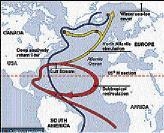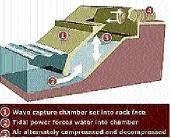While there has been much debate about different energy forms in recent months, the fact of the matter is that while the price of oil has been low, it is not likely to remain at such levels. It is still considered too volatile to be a viable sustainable source of energy for the economic development of the country.
In previous columns, alternative forms of renewable energy were explored including nuclear, solar, wind and ethanol from sugar cane and corn; but one vastly untapped and emerging technology is hydro-power using the oceans immense kinetic and potential energy through tides and current streams. Like other renewable sources of energy, hydro-power plants operational costs are not subject to the volatility of non-renewable resources such as coal and fossil fuels. However, they have the shortcomings where there is a lack of steady supply of energy from a power sources, as the main drivers are the result of weather patterns and seasonal changes - for example sun, wind and rainfall.
There are four main types of hydro-generating power:
Hydro-electricity - electricity generated from the difference in potential energy, due to a differential change of a flowing stream - a dam.
Wave power - which uses the energy of tidal waves for power generation
Tidal power - which takes advantage of the change in tidal levels for a semi-enclosed body of water. This is a horizontal difference that translates to a change in potential energy and kinetic energy.
Tidal stream power - on a vertical axis, this takes advantage of underwater ocean current streams.
Hydro-electric Power
Probably the most widely used and developed technology related to hydro-power generation; this is used on mainly rapid moving surface water sources, such as rivers and large streams. Run-of-river plants use natural stream flow for power generation, although a small dam is often used to supplement the head in such projects. The rate at which water flows into the dam roughly equals the rate at which water flows through the plant. In some projects, only part of the flow is diverted to the turbines and some plants use head ponds to impound water behind the dam thus storing enough energy to shift maximum power output to service peak electricity demand times.

5.

1.


Figure 1 http://en.wikipedia.org/wiki/File:Hydroelectric_dam.svg
Currently this type of hydropower accounts for 715,000 MWe or 19 per cent of world electricity and large dams are still being designed. In Jamaica alone there are eight hydroelectric dams that are operational and combined they provide a total of 23.8 MW of power to the national grid. (www.pcj.com)
Figure 2 Jamaica's hydro-electric plants - http://pcj.com/hydro_energy_main.htm
However, the ecological impact has begun to outweigh the cost-effectiveness of using this kind of setup for hydro-electricity. There have been known issues with diversification of water sources, causing overall aquatic population depletion and ecological changes.
Wave Power
While it is a newer technology, it is also a more used source of energy around the world, particularly in the United Kingdom. The objective is to use the kinetic energy of the waves to directly or indirectly to a chamber that turns a turbine, to produce electricity delivered on shore.
The power generator consists of two basic elements:
A wave energy collector
A generator to turn this into electricity
The energy collector comprises a sloping reinforced shell built into the rock face on the shoreline with an inlet big enough to allow sea water to freely enter and leave a central chamber. As waves enter the shell chamber, the level of water rises, compressing the air in the top of the chamber; this air is then forced through a 'blowhole' and into the 'Wells Turbine'.
It takes a significant amount of consistent wave force to run such an apparatus which is usually from a shore that borders an ocean. We here in Jamaica do not have such a shoreline.
Tidal Power
Harnessing the tides in a bay has been achieved in France (The Rance Tidal Power Plant), Canada and Russia, and could be achieved in certain other areas where there is a large tidal range. The trapped water can be used to turn turbines as it is released through the tidal barrage in either direction. Worldwide this technology appears to have little potential, largely due to environmental constraints, for a location where there is a consistent change in tide such as a bay or harbour. Kingston Harbour is the seventh largest natural harbour in the world, and this is a potential location for such a setup; however there are limitations to such a power supply. One possible fault is that the system would generate electricity most efficiently if it were to generate electricity in bursts, every six hours (once every tide), and this would be difficult in meeting the peak-load times, which may occur at the time the electricity bursts occur.
Tidal stream power
A relatively new technology development, tidal stream generators draw energy from underwater currents in much the same way that wind generators are powered by the wind.
The water at the ocean surface is moved primarily by winds that blow in certain patterns because of the Earth's spin and the Coriolis Effect. Winds are able to move the top 400 meters of the ocean creating surface ocean currents. Surface ocean currents form large circular patterns called gyres. Gyres flow clockwise in Northern Hemisphere oceans and counterclockwise in Southern Hemisphere oceans because of the Coriolis Effect creating surface ocean currents near the Earth's poles, gyres tend to flow in the opposite direction. Surface ocean currents flow in a regular pattern, but they are not all the same. Some currents are deep and narrow.
Figure 4 The world's oceanic tidal streams
Other currents are shallow and wide. Currents are often affected by the shape of the ocean floor. Some move quickly while others move more slowly. A current can also change somewhat in depth and speed over time. The much higher density of water means that there is the potential for a single generator to provide significant levels of power. Given that power varies with the density of medium and the cube of velocity, it is simple to see that water speeds of nearly one-tenth of the speed of wind provide the same power for the same size of turbine system. However this limits the application in practice to places where the tide moves at speeds of at least 2 knots (1m/s).
Figure 5 The scheme will use power from fast-moving tidal streams to turn a field of 300 60-foot high tidal 1MW turbines sitting on the sea floor. This gives the proposed scheme an operating capacity of 300MW http://renewableenergydev.com/red/tidal-power-south-korean-300mw-development/
Jamaica is on the sideline of the warm surface section a major ocean stream called the Gulf Stream that runs laterally across the Caribbean passing the southern region of the island (as shown in the figure), and continues northward-easterly to the eastern cost of North America. Any ocean current energy technology project planning will need to consider species protection (including fish and marine mammals) from injury from turning turbine blades. Consideration of shipping routes and present recreational uses, such as fishing and diving, will be required when considering siting of the turbines. Other considerations include risks from slowing the current flow by extracting energy.
Setup cost high
While the capital setup cost tends to be high (There is an agreement to develop a tidal power plant in the Wando Hoenggan waterway using 300 1MW turbine field at a construction cost of £500 million.) the operation cost are significantly lower at estimates of less than five cents per kilowatt hour. With virtually no cost associated with the production of electricity once built, it and considering the sustainability and availability of the energy source, it is well worth exploring.
The MIAS is a non-profit organisation of the University of the West Indies, Pure & Applied Sciences Department, offering analytical, technical and, web services and specialised science projects. If you have any question or comments about these articles please email: mias@uwimona.edu.jm or uwi.mias@gmail.com or contact the MIAS Analytical Services Division at 970-2042 or 512-3067 for enquires on services offered.